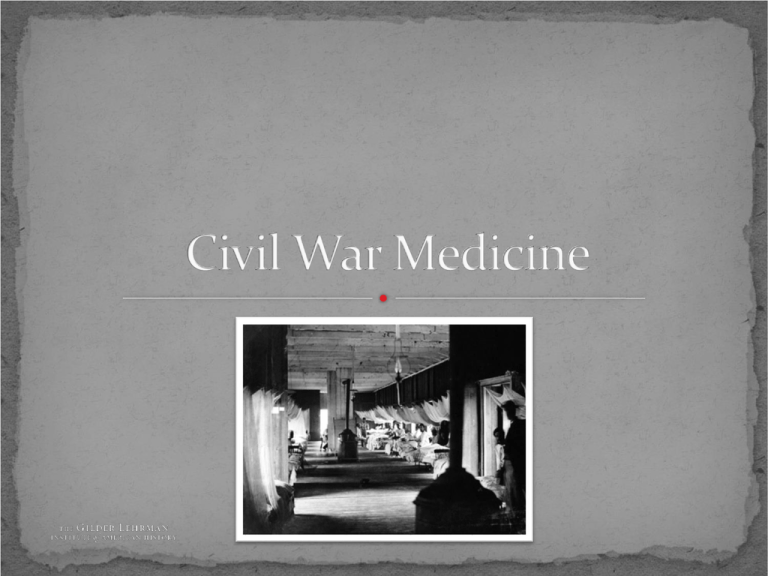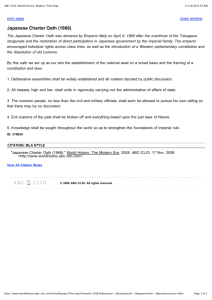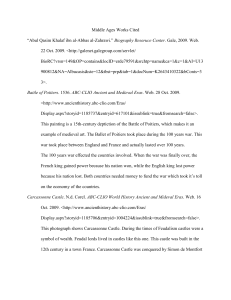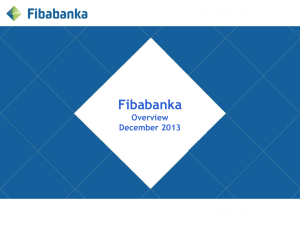Civil War Medicine PowerPoint - The Gilder Lehrman Institute of
advertisement

Most men did not die on the battlefield, but in a bed due to disease. Union Battle Deaths/Wounds – 110,070 Disease – c. 250,000 Confederacy Battle Deaths/Wounds – 94,000 Disease – 164,000 When supplies were brought to the warfront, ammunition was sent first, then rations, and then medical supplies. Medical equipment was bulky and hard to move, so they were often inaccessible. Surgical instruments were used on soldier after soldier without much more than a cleaning with water. Anesthesia was new and so several hundred surgeries were performed with no anesthesia. People often did not wash their hands before treating a wound. At this time people did not know about the transmission of bacteria. Men would put dirty rags over their wounds In order to stop hemorrhaging doctors would pack the wound with powerful astringent or chemicals often causing more harm. It was expected that wounds would fester and there was no relief, no pain killers or antibiotics. At the outbreak of the war, the armies nurses consisted of barely trained men. Approximately 2000 women in the North and South volunteered as nurses. Clara Barton This was a dangerous job, but many wanted to be at the frontlines. Dorthea Dix Private relief organization created in 1861 Believed that the government did a poor job of taking care of the health, comfort, and welfare of the soldiers, so they volunteered to help. Inspected cooking, clothing, and sanitation of Union soldier encampments. Predict what it might be like to be a wounded soldier during the Civil War. Describe the day. Include the following: How did you get hurt? What was the surgery like? What are the conditions like? Who did you meet? How do you feel? Are you scared of anything? Content "The Civil War Army Surgeon and His Work." The American Civil War Home Page. Web. 01 Dec. 2010. <http://civilwarhome.com/armysurgeon.htm>. "Casualties and Costs of the Civil War." Digital History. Web. 01 Dec. 2010. <http://www.digitalhistory.uh.edu/historyonline/us20.cfm>. "Civil War Hospitals, Surgeons, and Nurses." The American Civil War Home Page. Web. 01 Dec. 2010. <http://civilwarhome.com/hospitalssurgeonsnurses.htm>. "The Sanitary Commission To The Rescue." The American Civil War Home Page. Web. 01 Dec. 2010. <http://civilwarhome.com/sanitarycommtorescue.htm>. Photos "Harewood Hospital in Washington, D.C." Image. Library of Congress. American History. ABC-CLIO, 2010. Web. 1 Dec. 2010. "Doctors examine Civil War prisoner." Image. Library of Congress. American History. ABC-CLIO, 2010. Web. 1 Dec. 2010. http://www.civilwarbooklady.com/images/Civil_War_Medicine.jpg "Amputation at Civil War hospital." Image. National Archives. American History. ABC-CLIO, 2010. Web. 1 Dec. 2010. "Civil War ambulance." Image. Library of Congress. American History. ABC-CLIO, 2010. Web. 1 Dec. 2010. http://www.gwu.edu/gelman/spec/exhibits/pnc_riggs/exhibit_images/Clara-Barton.jpg http://www.franklin.ma.us/auto/upload/schools/fhs/2675-dorothea-dix.jpg "U.S. Sanitary Commission nurses and officers." Image. Library of Congress. American History. ABC-CLIO, 2010. Web. 1 Dec. 2010. "U.S. Sanitary Commission quarters." Image. National Archives. American History. ABC-CLIO, 2010. Web. 1 Dec. 2010. "Battle of Gettysburg casualties." Image. National Archives. American History. ABC-CLIO, 2010. Web. 1 Dec. 2010. "Battle of the Wilderness." Image. Library of Congress. American History. ABC-CLIO, 2010. Web. 1 Dec. 2010.











